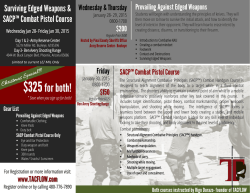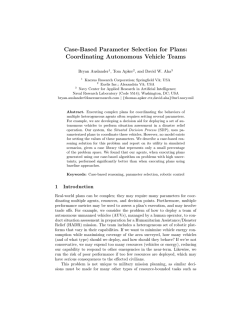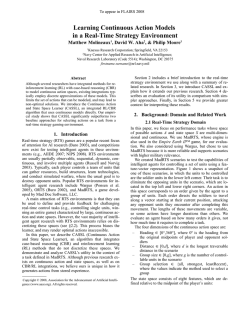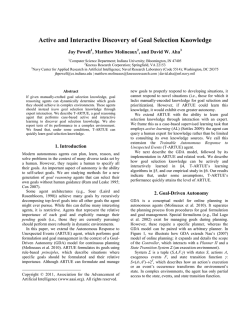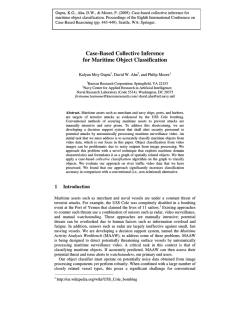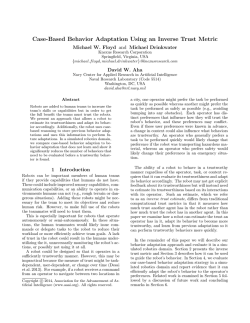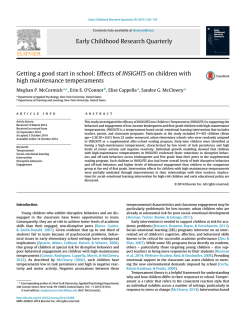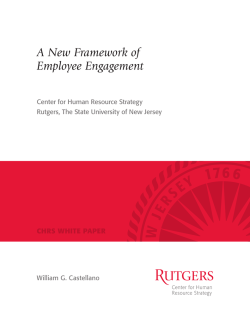
(Borck et al. 2014 8 27b) Case Based Behavior Recognition to
Case-Based Behavior Recognition
to Facilitate Planning in Unmanned Air Vehicles
Hayley Borck1, Justin Karneeb1, Ron Alford2, David W. Aha3
1
Knexus Research Corporation; Springfield, VA; USA
ASEE Postdoctoral Fellow; Naval Research Laboratory (Code 5514); Washington DC; USA
3
Navy Center for Applied Research in Artificial Intelligence;
Naval Research Laboratory (Code 5514); Washington, DC; USA
{first.last}@knexusresearch.com | {david.aha, ronald.alford.ctr}@nrl.navy.mil
2
Abstract. An unmanned air vehicle (UAV) can operate as a capable team
member in mixed human-robot teams if the agent that controls it can
intelligently plan. However, planning effectively in an air combat scenario
requires understanding the behaviors of hostile agents in that scenario, which is
challenging in partially observable environments such as the one we study. We
present a Case-Based Behavior Recognition (CBBR) algorithm that annotates
an agent’s behaviors using a discrete feature set derived from a continuous
spatio-temporal world state. These behaviors can then be given as input to an air
combat simulation, along with the UAV’s plan, to predict hostile actions and
determine the effectiveness of the given plan. We describe an initial
implementation of a CBBR prototype in the context of a goal reasoning agent
designed for UAV control.
1
Introduction
Unmanned air vehicles (UAVs) can be capable wingmen in air combat scenarios
when given an accurate plan to execute [1]. However, planning may be ineffective if
the behaviors of the other agents operating in the world are unknown. To effectively
account for hostile and allied agents we will use a Case-based Behavior Recognition
(CBBR) algorithm that, in combination with a predictive planner, can effectively
evaluate UAV plans in real time. In our work, a wingman is a UAV that is given a
mission to complete and may optionally also receive orders from a human pilot. In the
situations where the UAV’s agent does not receive explicit orders, it must create a
plan for itself.
We define a behavior as an overarching tendency or policy of the agent. Behaviors
are encoded in a directed graph where each node is an action, such as ‘fly to target’ or
‘fire missile’. The domain we are working with is Beyond Visual Range Air Combat,
which entails precise tactics at large distances. In this domain we have little data
about the hostile agents, and what we do have is partially observable. Yet if the UAV
can identify a hostile agent’s behavior or plan it can use that information when
creating and evaluating its own plan.
We hypothesize that behavior recognition is more effective than plan recognition in
domains where information is scarce. We designed our CBBR implementation so that,
by discretizing state information over time, it can identify a hostile agent’s current
behavior. CBBR currently operates in two 2 vs 2 scenarios (i.e., each scenario
involves two ‘friendly’ aircraft versus two ‘enemy’ aircraft). In our first scenario a
pilot and their UAV wingman are conducting an attack, while in the second they are
defending a specified area.
In the rest of this paper we describe our agent for intelligent control of UAVs in the
Beyond Visual Range Air Combat domain, focusing on its CBBR component. In
Section 2 we summarize related work. In Section 3 we provide a model of the
Tactical Battle Manager (TBM), which includes our CBBR component. In Section 4,
we describe its case structure and similarity function. Section 5 details a simple
example, and Section 6 concludes and describes potential future work.
2
Related Work
Our behavior recognition component, which lies within a larger goal reasoning (GR)
agent (i.e., the TBM), can determine if a UAV wingman’s plan is effective. In recent
years, case-based reasoning (CBR) has been an active area of research for GR agents.
For example, Weber et al. [2] use a case base to formulate new goals for an agent.
Jaidee et al. [3] uses CBR techniques for goal selection and reinforcement learning
(RL) for goal-specific policy selection. In contrast, our system uses CBR to recognize
the behavior of other agents, so that we can predict their responses to our agent’s
actions.
Opponent agents can be recognized as a team or as a single agent. Team
composition can be dynamic [4], resulting in a more complex version of the plan
recognition problem [5]. Another approach to team dynamics involves setting
multiagent planning parameters, as addressed by Auslander et al. [6], which are then
given to a plan generator. Recognizing higher-level behaviors encompasses these
team behaviors. For example, two hostile agents categorized as ‘all out aggressive’ in
our system could, acting according to the ‘all out aggressive’ graph, execute a pincer
maneuver (a maneuver in which two agents attack both flanks of an opponent).
A challenging task in agent planning is inferring the states of any adversarial
agents because their strategies can change over time. Auslander et al. [7] use a casebased reinforcement learner to combat changing conditions and overcome slow
learning by employing a case base of winning policies. Rao and Murray [8] store the
mental states of the agent representing their beliefs, desires, and intentions and use
those to synthesize plans. Similarly, Jaidee et al. [9] use dual case bases to learn goals
and agent policies, making their approach more flexible than either case-based
learning or RL alone. Smith et al. [10] use a genetic algorithm (GA) system to
develop effective tactics for their agents in a two-sided learning experiment. Aha et al.
[11] employed a case base to select sub-plans for agents at each state and keep the
opponent agents at bay. To ensure our case-based solutions are robust to dynamic
behaviors, we use global features in our cases to serve as a memory of past actions
and tendencies. We also frequently update the agent’s behaviors, which enables the
most recent information to be used for future planning.
3
Tactical Battle Manager
The TBM (Figure 1) is a set of systems for pilot-UAV interaction and autonomous
UAV control. The UAV’s intelligent controller, which is the focus of this paper, takes
as input an incomplete world state and outputs, and subsequently executes, a plan for
the UAV. Each known agent in a scenario is represented in the world model, which
contains the agent’s past observed states and future predicted states as well as its
capabilities and currently recognized behavior. A complete state contains, for each
time step in the simulation, the position and actions for each known agent. An
example of an action in our system is ‘fire missile’ or ‘fly to target’. For the UAV and
its allies the past states are complete. However, any hostile agent’s position for a
given time is known only if the hostile agent appears on the UAV’s radar or the radar
of one of its allies. Also, a hostile agent’s actions are never known and must be
inferred from the potentially incomplete past states. The capabilities of an aircraft are
currently given, though in future work they will be inferred through observations. In
Section 4 we describe the behaviors and how they are modeled by the CBBR
algorithm.
The updated world model is passed to the Goal Management System (GMS). This
follows the normal goal reasoning cycle and is complemented by a desire system
similar to a Belief Desire Intention (BDI) [12] architecture. The GMS maintains a set
of goals based on the world model; it adds, removes, and reprioritizes them as
necessary. These goals are used to generate a plan for the UAV with a corresponding
set of predicted states for all agents. We refer to the system that performs these tasks
as the Predictive Planner. Currently this planner is simple. However, we use a more
sophisticated Plan Expectation Predictor (PEPR) to generate the predicted states; it
runs an instance of the Air Force Simulator (AFSIM), which is a mature air combat
simulation engine that is used by the USAF. AFSIM simulates the plan for the UAV
and the other agents in a scenario by projecting their behaviors to determine the
effectiveness of the UAV’s plan. Thus, the predicted future states are only as accurate
as the behaviors contained in our models.
Fig. 1. Tactical Battle Manager (TBM) Architecture
4
Case-Based Behavior Recognition
The following subsections describe the CBBR algorithm in detail. The traditional
CBR cycle consists of four steps: retrieval, reuse, revise, and retain. Currently our
algorithm employs only steps for retrieval and reuse. In future work we plan to
expand the algorithm to include steps for revision and retention.
4.1
Case Representation
A case in our system represents an agent over time. Cases are represented as
〈problem, solution〉 pairs. A problem is represented by a set of features that discretize
the agent’s model, while a solution is the behavior the agent was employing. The
feature set contains two feature types: features that occur at a specific time step and
global features (Figure 2). Global features act as a memory and represent overarching
tendencies about how the agent has acted in the past. Time step features represent
features that affect the agent for the duration of the time step.
To keep the cases lean, we merge time steps that have the same features and sum
their durations. Features can be represented as a boolean value or a percentage. We
represent some features using a percentage value because it more fully describes a
situation than does a boolean. For example the hasTrack feature, which describes
whether an agent has another agent in its radar, is defined as the ratio of agents it has
in its radar versus the total number of agents it currently knows exists in a scenario.
The currently modeled behaviors are:
• All Out Aggressive: an agent attacks and is not concerned for its safety.
• Safety Aggressive: an agent that attacks but has concern for its safety.
• Defensive: an agent that only attacks when a hostile agent is within a certain area.
• Oblivious: an agent that acts as if hostile agents are not near.
• Passive: an agent that knows hostile agents are near but does not attack.
Fig. 2. A case’s design, including problem features and solution behaviors
4.2
Case Base Population
We populated our case base by running several 2 vs 2 scenarios in AFSIM, where the
hostiles were encoded with explicit behaviors to exhibit. For example, a 2 vs 2
scenario was run where both hostiles had all out aggressive behaviors and the pilot
and UAV ran simple passive behaviors (in which they try to keep the hostiles in radar
range but do not attack). Cases are created from the hostiles in the scenario and
recorded in an xml file. We prune the cases twice; first during case generation and
also after all the scenarios have been run. The first stage of pruning prevents cases
with the same problem features and solution behavior to be added to the case base.
The second stage deletes cases from the case base if their problem features are
identical but their behaviors differ.
4.3
Case Similarity
To calculate the similarity between a query q and a case c’s problem descriptions, we
compute a weighted average from the sum of the distances between their matching
global and time step features in cases. We use a weight of α for time step features and
β for global features, where α and β are both non-negative numbers that sum to 1. If a
query contains mismatched features to a case (features that are not present in the case,
or features in a case that are not present in the query) then those features are ignored
in the similarity equation. Similarity is calculated in reverse chronological order, with
a discount factor δ applied based on how far in the past the feature occurred. The full
equation is shown below, where σ(qf,cf) is the distance between two values for
(matching) feature f, N is the set of time step features, and M is the set of global
features.
sim 𝑞, 𝑐 = − 𝛼
!∈!
𝛿 ∙ 𝜎 𝑞! , 𝑐!
𝑁
−𝛽
!∈! 𝜎
𝑞! , 𝑐!
(1)
𝑀
We are currently identifying values to use for these weights and the discount factor.
Future work will include optimizing these variables.
Once the case with the most similar problem description is found its (solution)
behavior is retrieved and used as the predicted behavior of the currently observed
agent. The world model is also updated with that agent’s predicted behavior, which is
used by PEPR to predict future states.
5
Discussion
In Section 5.1 we present a simple example of the case structure and similarity metric
in the domain of Beyond Visual Range Air Combat. Following that, in Section 5.2 we
briefly describe the evaluations we intend to conduct in the future.
5.1
A Simple Example
In a simple example of the CBBR system, we have a case base in a 2 vs 2 scenario.
The agents are modeled using discrete time step and global features. Here we define
each case to have time steps of 5 seconds (i.e., a trace of 15 seconds of observed
states is split into three time steps). Global features are extracted from the entire
trace’s observed states. Below we show an example of a query q1, where a hostile
agent followed an agent friendly to the UAV for two time steps and then turned away
at the third time step.
[q1] Behavior: ?
List<TimeStep> timeSteps =
{d=5, hasTrack(.5), isFacing(.5) hasWeaponLeft(T)}
{d=5, hasTrack(.5), isFacing(.5), hasWeaponLeft(T),
isClosingOnEntities(.5)}
{d=5. hasTrack(.5), hasWeaponLeft(T)}
List<GlobalFeature> gFeatures =
{hasSeenOpposingTeam(.5), hasAggressiveTendencies(.5)}
In query q1 we can see the hostile agent is following a friendly agent because it has
a friendly in its radar (hasTrack), is facing a friendly agent, and is closing on a
friendly agent. Since there are two friendly agents in the scenario but the hostile is
only following one of them the features have a value of 0.5. We do not record which
agent this hostile is following, but only that it is following one of them. This is
because knowing which friendly the hostile agent is following will not affect which
behavior the agent is exhibiting. The hasWeaponLeft time step feature is the only one
shown that is represented by a boolean value. (In this example we did not infer that
the hostile fired a weapon, and therefore believe it still has one or more weapons
remaining.)
For this example consider two cases in the case base, c2 and c3. Case c2 is an
example of a passive behavior, which often involves flying away from an enemy and
avoiding conflict. Case c3 is an example of an all out aggressive behavior, which is
similar to the query q1. The case retrieval step would return case c3 due to the
similarity of the features in their first two time steps, and their global features. As
mentioned previously the mismatched features at the third time step do not count
against the similarity between q1 and either of the other cases. Thus, for this situation
the agent described by query q1 would be predicted to be an all out aggressive agent.
[C2] Behavior: Passive
List<TimeStep> timeSteps =
{d=5, hasWeaponLeft(T)}
{d=5, hasWeaponLeft(T)}
List<GlobalFeature> gFeatures =
{hasSelfPreservationTendencies(.5)}
[C3] Behavior: All Out Aggressive
List<TimeStep> timeSteps =
{d=5, hasTrack(1), isFacing(1), hasWeaponLeft(T)}
{d=5, hasTrack(1), isFacing(1), hasWeaponLeft(T),
isClosingOnEntities(1)}
List<GlobalFeature> gFeatures =
{hasSeenOpposingTeam(.5), hasAggressiveTendencies(.5)}
5.2
Future Empirical Studies
To evaluate our CBBR component we plan to conduct several experiments. The
objective of the first experiment will be to determine the effectiveness of CBBR as
compared to other behavior recognizers, including baseline algorithms. To do this we
will compare CBBR to a random behavior choice, a random behavior choice based on
a predetermined percentage, and a rule-based system. Additionally, since we
hypothesize a behavior recognizer is more robust than a plan recognizer in a domain
with partial information we will compare the two approaches empirically. Lastly we
plan to assess the effectiveness of the UAV’s plan, since the end goal of CBBR is to
help identify whether a UAV’s plan will succeed as predicted by PEPR.
6
Summary
In this paper we presented a Case-Based Behavior Recognizer that, in our domain
(Beyond Visual Range Air Combat), facilitates planning in unmanned air vehicles.
This behavior recognizer is given a trace of spatio-temporal information, which may
be incomplete. Our CBBR component is designed to identify overarching behaviors
(e.g., aggressive or passive) rather than plans. In our future work we will empirically
compare CBBR versus other behavior and plan recognizers, and also assess the
effectiveness of the plan. We will also expand the behavior recognizer to reason with
possibly mislabeled state information and more complex team tactics.
Acknowledgements
Thanks to OSD ASD (R&E) for sponsoring this research. The views and opinions
contained in this paper are those of the authors and should not be interpreted as
representing the official views or policies, either expressed or implied, of NRL or
OSD.
References
1. Nielsen, P., Smoot, D., Dennison, J.D.: Participation of TacAir-Soar in RoadRunner and
Coyote Exercises at Air Force Research Lab, Mesa AZ. Technical report (2006)
2. Weber, B. G., Mateas, M., Jhala, A.: Case-based Goal Formulation. In: AAAI Workshop
on Goal-Driven Autonomy (2010)
3. Jaidee, U., Munoz-Avila, H., & Aha, D.W.: Case-based goal-driven coordination of multiple learning agents. In: 21st International Conference on Case-Based Reasoning. (2013) pp.
164-178.
4. Sukthankar, G., Sycara, K.P.: Simultaneous Team Assignment and Behavior Recognition
from Spatio-Temporal Agent Traces. In: 21st National Conference on Artificial
Intelligence. (2006) 716-721
5. Sukthankar, G., Sycara, K.P.: Activity Recognition for Dynamic Multi-Agent Teams.
ACM Trans. on Intell. Syst. Technol. (2011) 18
6. Auslander, B., Apker, T., Aha, D.W.: Case-Based Parameter Selection for Plans:
Coordinating Autonomous Vehicle Teams. In: 22nd International Conference on CaseBased Reasoning. (2014) 189-203
7. Auslander, B., Lee-Urban, S., Hogg, C., Muñoz-Avila, H.: Recognizing the Enemy:
Combining Reinforcement Learning with Strategy Selection Using Case-Based Reasoning.
In: 9th European Conference on Case-Based Reasoning. (2008) 59-73
8. Rao, A.S., Murray, G.: Multi-agent Mental-State Recognition and its Application to AirCombat Modelling. In: 13th International Workshop on Distributed Artificial Intelligence
(1994) 283-304
9. Jaidee, U., Muñoz-Avila, H., Aha, D.W.: Case-based Learning in Goal-driven Autonomy
Agents for Real-Time Strategy Combat Tasks. In: 19th International Conference on CaseBased Reasoning. (2011) 43-52
10. Smith, R.E., Dike, B.A., Mehra, R.K., Ravichandran, B., El-Fallah, A.: Classifier Systems
in Combat: Two-Sided Learning of Maneuvers for Advanced Fighter Aircraft. Computer
Methods in Applied Mechanics and Engineering 186(2) (2000) 421-437
11. Aha, D.W., Molineaux, M., Ponsen, M.J.V.: Learning to Win: Case-Based Plan Selection
in a Real-Time Strategy Game. In: International Conference on Case-Based Reasoning.
(2005) 5-20
12. Rao, A.S., Georgeff, M.P.: Modeling rational agents within a BDI-architecture. In: 2nd International Conference on Principles of Knowledge Representation and Reasoning. (1991)
473-484
© Copyright 2025


